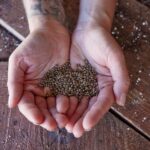One of the most important decisions any cultivator will make is choosing what genetics to grow. As the industry matures and consumers become more educated about cannabinoids, terpenes, and their effects, the genetics you choose will have an increased impact on the success of your operation. No matter where you operate, the current market likely is more competitive than ever, and genetic variety is helping to set brands apart. Offering a menu of unique and remarkable traits from an “elite cultivar” is becoming a minimum requirement for well-established brands and startups alike. There are thousands of cultivars to choose from, so let’s explore why genetics are so important—and how you can choose the right ones for your operation.
I started Yellowhammer Genetics in Alabama during the early 2000s. At the time, there were only a handful of known cannabis breeders, and getting your hands on verified genetics was difficult—sometimes even dangerous. Fortunately, things have changed, and getting the hottest new genetics directly from the breeder is as easy as tapping the screen on your smartphone a few times and then checking your mail a few days later.
Provenance matters
When it comes to sourcing genetics, the provenance—or proof the company with which you are dealing is reputable—is by far the most important step in the process. Reach out to the breeder directly to ask questions about any specific traits and characteristics of the cultivars you choose. Gather as much information about the performance of the cultivar as possible: yield data, certificates of authenticity, disease testing, grow reports, and photographs. Most reputable breeders and seed banks will be more than happy to answer questions, and establishing this relationship early in the process is a good business practice. Ask about any licensing or material transfer agreements, and make sure to give credit to the breeders later in your marketing and advertising efforts. Their hard work will help build your brand and ensure the success of your operation.
Building relationships
The relationship between cultivation operations and plant breeders is trending toward a more traditional agricultural model. Cannabis genetics are intellectual property (IP), and an elite cultivar could be worth millions of dollars in revenue in addition to the value it can generate by winning awards. Prohibition led to an open-source and public-domain model because there were no mechanisms available for breeders to protect their IP. Now, we are seeing a clash between the culture of cannabis and the business of cannabis. Most breeders I know, myself included, did not risk decades in jail for the chance to receive a royalty check. For us, the work was about the creation of something new and unique, and it was all for the love of the plant. However, the current market is dictating a change in this paradigm. Cultivators should want to work closely with breeders, since no one will know cultivars as well as they do.
When choosing cultivars, it’s wise to start with considering the environment and cultivation methods. History has led to the development of cultivars suited for both outdoor and indoor cultivation, but not all cultivars do well in both cultivation environments. Geographic location and hardiness zone will be important factors when choosing plants for outdoor operations. Investigate how the cultivar you are considering might perform in your environment, and try to discover whether the plant was bred specifically for indoor or outdoor cultivation. A cultivator with a greenhouse in southern Florida might be well advised not to choose a cultivar bred to perform well at the high altitudes of southwest Colorado.
Flowering time
Flowering time, or the time it takes from the beginning of the flowering cycle until the flower has ripened, can have a significant impact on an operation’s success. If your cultivation schedule is set to an eight-week flowering cycle, choosing a cultivar that takes ten weeks to ripen would be unwise. I have seen this in large-scale operations quite often, as well as in smaller grows. The market is demanding a true Haze or perhaps Sour Diesel, which can take ten to twelve weeks to mature, yet the operation does not adjust its cultivation schedule to accommodate the longer flowering time. The result is an immature flower of low potency and poor quality that likely will be difficult to sell. This is a huge loss for both consumers and the business, as key performance indicators suffer and market demands are not met.
Many varieties will ripen fully within an eight-week schedule, and a good grower can help to shorten flowering times with advanced cultivation techniques. It helps if the cultivator can build flexibility into the cultivation schedule to accommodate changes in market trends and achieve variable flowering times.
Pheno hunting
Discussing the importance of genetics without discussing “pheno hunting” is almost impossible. The phrase often is used to describe the process of germinating multiple seeds of the same cultivar and growing them to fruition to determine which, if any, of the resulting phenotypes meet the requirements for inclusion in the production schedule. Pheno hunts offer each cultivator the opportunity to place a one-of-a-kind product on the menu. As mentioned previously, a phenotype that becomes an elite cultivar or “keeper cut” could be worth millions of dollars.
Depending on whether the goal is finished flower, extract, or both, a pheno hunt is the first place to observe the desired traits when growing a cultivar for the first time. Prior research and communication with the breeder will provide valuable insight during this time and may make the selection process easier. Cultivators should consider pheno hunts as they would any other investment in the company. Typically, pheno hunts take about a year from seed to final selection.
Cannabinoid and terpene content
Another important aspect of genetics and their importance to a business’s success is cannabinoid and terpene content—not only concentration, but also variety, the spice of life. For more than three decades, when concentration laid the foundation of modern cannabis breeding work, only one cannabinoid was of any real interest: THC. Most of the work was done by small-scale breeding operations in basements, attics, and hidden gardens off the beaten trail in the woods. Over those decades, THC levels doubled and then tripled, with certain cultivars now capable of producing THC concentrations higher than 30 percent.
Demand for high-potency flower has driven the cannabis genetics industry and continues to be an important metric in deciding which cultivars to select. However, with the arrival of the hemp industry in 2014, other cannabinoids have become readily available and the market is beginning to see demand for unique combinations. While these combinations are not as common as THC-dominant strains, several great breeders offer varying ratios of CBD:THC, CBG:THC:CBD, THCV:CBG, and so on. Cultivars with unique cannabinoid ratios open a whole new category of choices and treatments for the market.
Choose wisely
Choosing the right genetics is vital to the success of any cannabis operation. Many factors influence a breeder’s decision to create new cultivars, but it is ultimately cultivators who choose what to grow based on a wide range of factors. Cultivators work to stay ahead of the curve, watching the market and trying to determine what’s hot and what’s not. Flower that sells faster than ice at Burning Man one month may sit on shelves for weeks the next.
Having a selection of “elite” cultivars is a great defense against an ever-changing market. Genetics provide the foundation for the brands they help build. A great example is the brand Cookies, which was built on the original cultivar of the same name (along with a lot of hard work and dedication). Working with the breeder early in the process paid off significantly in the long run.
Knowledge, craft, and experience should never be minimized, but successful genetics also help build successful brands.














[…] Genetics Are the Foundation for Success Advertisement .td-post-sharing-classic{position:relative;height:20px}.td-post-sharing{margin-left:-3px;margin-right:-3px;font-family:'Open Sans','Open Sans Regular',sans-serif;z-index:2;white-space:nowrap;opacity:0}.td-post-sharing.td-social-show-all{white-space:normal}.td-js-loaded .td-post-sharing{-webkit-transition:opacity 0.3s;transition:opacity 0.3s;opacity:1}.td-post-sharing-classic+.td-post-sharing{margin-top:15px}@media (max-width:767px){.td-post-sharing-classic+.td-post-sharing{margin-top:8px}}.td-post-sharing-top{margin-bottom:30px}@media (max-width:767px){.td-post-sharing-top{margin-bottom:20px}}.td-post-sharing-bottom{border-style:solid;border-color:#ededed;border-width:1px 0;padding:21px 0;margin-bottom:42px}.td-post-sharing-bottom .td-post-sharing{margin-bottom:-7px}.td-post-sharing-visible,.td-social-sharing-hidden{display:inline-block}.td-social-sharing-hidden ul{display:none}.td-social-show-all .td-pulldown-filter-list{display:inline-block}.td-social-network,.td-social-handler{position:relative;display:inline-block;margin:0 3px 7px;height:40px;min-width:40px;font-size:11px;text-align:center;vertical-align:middle}.td-ps-notext .td-social-network .td-social-but-icon,.td-ps-notext .td-social-handler .td-social-but-icon{border-top-right-radius:2px;border-bottom-right-radius:2px}.td-social-network{color:#000;overflow:hidden}.td-social-network .td-social-but-icon{border-top-left-radius:2px;border-bottom-left-radius:2px}.td-social-network .td-social-but-text{border-top-right-radius:2px;border-bottom-right-radius:2px}.td-social-network:hover{opacity:0.8!important}.td-social-handler{color:#444;border:1px solid #e9e9e9;border-radius:2px}.td-social-handler .td-social-but-text{font-weight:700}.td-social-handler .td-social-but-text:before{background-color:#000;opacity:0.08}.td-social-share-text{margin-right:18px}.td-social-share-text:before,.td-social-share-text:after{content:'';position:absolute;top:50%;-webkit-transform:translateY(-50%);transform:translateY(-50%);left:100%;width:0;height:0;border-style:solid}.td-social-share-text:before{border-width:9px 0 9px 11px;border-color:transparent transparent transparent #e9e9e9}.td-social-share-text:after{border-width:8px 0 8px 10px;border-color:transparent transparent transparent #fff}.td-social-but-text,.td-social-but-icon{display:inline-block;position:relative}.td-social-but-icon{padding-left:13px;padding-right:13px;line-height:40px;z-index:1}.td-social-but-icon i{position:relative;top:-1px;vertical-align:middle}.td-social-but-text{margin-left:-6px;padding-left:12px;padding-right:17px;line-height:40px}.td-social-but-text:before{content:'';position:absolute;top:12px;left:0;width:1px;height:16px;background-color:#fff;opacity:0.2;z-index:1}.td-social-handler i,.td-social-facebook i,.td-social-reddit i,.td-social-linkedin i,.td-social-tumblr i,.td-social-stumbleupon i,.td-social-vk i,.td-social-viber i,.td-social-flipboard i,.td-social-koo i{font-size:14px}.td-social-telegram i{font-size:16px}.td-social-mail i,.td-social-line i,.td-social-print i{font-size:15px}.td-social-handler .td-icon-share{top:-1px;left:-1px}.td-social-twitter .td-icon-twitter{font-size:14px}.td-social-pinterest .td-icon-pinterest{font-size:13px}.td-social-whatsapp .td-icon-whatsapp,.td-social-kakao .td-icon-kakao{font-size:18px}.td-social-kakao .td-icon-kakao:before{color:#3C1B1D}.td-social-reddit .td-social-but-icon{padding-right:12px}.td-social-reddit .td-icon-reddit{left:-1px}.td-social-telegram .td-social-but-icon{padding-right:12px}.td-social-telegram .td-icon-telegram{left:-1px}.td-social-stumbleupon .td-social-but-icon{padding-right:11px}.td-social-stumbleupon .td-icon-stumbleupon{left:-2px}.td-social-digg .td-social-but-icon{padding-right:11px}.td-social-digg .td-icon-digg{left:-2px;font-size:17px}.td-social-vk .td-social-but-icon{padding-right:11px}.td-social-vk .td-icon-vk{left:-2px}.td-social-naver .td-icon-naver{left:-1px;font-size:16px}.td-social-gettr .td-icon-gettr{font-size:25px}.td-ps-notext .td-social-gettr .td-icon-gettr{left:-5px}.td-social-copy_url{position:relative}.td-social-copy_url-check{position:absolute;top:50%;left:50%;transform:translate(-50%,-50%);color:#fff;opacity:0;pointer-events:none;transition:opacity .2s ease-in-out;z-index:11}.td-social-copy_url .td-icon-copy_url{left:-1px;font-size:17px}.td-social-copy_url-disabled{pointer-events:none}.td-social-copy_url-disabled .td-icon-copy_url{opacity:0}.td-social-copy_url-copied .td-social-copy_url-check{opacity:1}@keyframes social_copy_url_loader{0%{-webkit-transform:rotate(0);transform:rotate(0)}100%{-webkit-transform:rotate(360deg);transform:rotate(360deg)}}.td-social-expand-tabs i{top:-2px;left:-1px;font-size:16px}@media (min-width:767px){.td-social-line,.td-social-viber{display:none}}.td-ps-bg .td-social-network{color:#fff}.td-ps-bg .td-social-facebook .td-social-but-icon,.td-ps-bg .td-social-facebook .td-social-but-text{background-color:#516eab}.td-ps-bg .td-social-twitter .td-social-but-icon,.td-ps-bg .td-social-twitter .td-social-but-text{background-color:#29c5f6}.td-ps-bg .td-social-pinterest .td-social-but-icon,.td-ps-bg .td-social-pinterest .td-social-but-text{background-color:#ca212a}.td-ps-bg .td-social-whatsapp .td-social-but-icon,.td-ps-bg .td-social-whatsapp .td-social-but-text{background-color:#7bbf6a}.td-ps-bg .td-social-reddit .td-social-but-icon,.td-ps-bg .td-social-reddit .td-social-but-text{background-color:#f54200}.td-ps-bg .td-social-mail .td-social-but-icon,.td-ps-bg .td-social-digg .td-social-but-icon,.td-ps-bg .td-social-copy_url .td-social-but-icon,.td-ps-bg .td-social-mail .td-social-but-text,.td-ps-bg .td-social-digg .td-social-but-text,.td-ps-bg .td-social-copy_url .td-social-but-text{background-color:#000}.td-ps-bg .td-social-print .td-social-but-icon,.td-ps-bg .td-social-print .td-social-but-text{background-color:#333}.td-ps-bg .td-social-linkedin .td-social-but-icon,.td-ps-bg .td-social-linkedin .td-social-but-text{background-color:#0266a0}.td-ps-bg .td-social-tumblr .td-social-but-icon,.td-ps-bg .td-social-tumblr .td-social-but-text{background-color:#3e5a70}.td-ps-bg .td-social-telegram .td-social-but-icon,.td-ps-bg .td-social-telegram .td-social-but-text{background-color:#179cde}.td-ps-bg .td-social-stumbleupon .td-social-but-icon,.td-ps-bg .td-social-stumbleupon .td-social-but-text{background-color:#ee4813}.td-ps-bg .td-social-vk .td-social-but-icon,.td-ps-bg .td-social-vk .td-social-but-text{background-color:#4c75a3}.td-ps-bg .td-social-line .td-social-but-icon,.td-ps-bg .td-social-line .td-social-but-text{background-color:#00b900}.td-ps-bg .td-social-viber .td-social-but-icon,.td-ps-bg .td-social-viber .td-social-but-text{background-color:#5d54a4}.td-ps-bg .td-social-naver .td-social-but-icon,.td-ps-bg .td-social-naver .td-social-but-text{background-color:#3ec729}.td-ps-bg .td-social-flipboard .td-social-but-icon,.td-ps-bg .td-social-flipboard .td-social-but-text{background-color:#f42827}.td-ps-bg .td-social-kakao .td-social-but-icon,.td-ps-bg .td-social-kakao .td-social-but-text{background-color:#f9e000}.td-ps-bg .td-social-gettr .td-social-but-icon,.td-ps-bg .td-social-gettr .td-social-but-text{background-color:#fc223b}.td-ps-bg .td-social-koo .td-social-but-icon,.td-ps-bg .td-social-koo .td-social-but-text{background-color:#facd00}.td-ps-dark-bg .td-social-network{color:#fff}.td-ps-dark-bg .td-social-network .td-social-but-icon,.td-ps-dark-bg .td-social-network .td-social-but-text{background-color:#000}.td-ps-border .td-social-network .td-social-but-icon,.td-ps-border .td-social-network .td-social-but-text{line-height:38px;border-width:1px;border-style:solid}.td-ps-border .td-social-network .td-social-but-text{border-left-width:0}.td-ps-border .td-social-network .td-social-but-text:before{background-color:#000;opacity:0.08}.td-ps-border.td-ps-padding .td-social-network .td-social-but-icon{border-right-width:0}.td-ps-border.td-ps-padding .td-social-network.td-social-expand-tabs .td-social-but-icon{border-right-width:1px}.td-ps-border-grey .td-social-but-icon,.td-ps-border-grey .td-social-but-text{border-color:#e9e9e9}.td-ps-border-colored .td-social-facebook .td-social-but-icon,.td-ps-border-colored .td-social-facebook .td-social-but-text{border-color:#516eab}.td-ps-border-colored .td-social-twitter .td-social-but-icon,div.td-ps-border-colored .td-social-twitter .td-social-but-text{border-color:#29c5f6;color:#29c5f6}.td-ps-border-colored .td-social-pinterest .td-social-but-icon,.td-ps-border-colored .td-social-pinterest .td-social-but-text{border-color:#ca212a}.td-ps-border-colored .td-social-whatsapp .td-social-but-icon,.td-ps-border-colored .td-social-whatsapp .td-social-but-text{border-color:#7bbf6a}.td-ps-border-colored .td-social-reddit .td-social-but-icon,.td-ps-border-colored .td-social-reddit .td-social-but-text{border-color:#f54200}.td-ps-border-colored .td-social-mail .td-social-but-icon,.td-ps-border-colored .td-social-digg .td-social-but-icon,.td-ps-border-colored .td-social-copy_url .td-social-but-icon,.td-ps-border-colored .td-social-mail .td-social-but-text,.td-ps-border-colored .td-social-digg .td-social-but-text,.td-ps-border-colored .td-social-copy_url .td-social-but-text{border-color:#000}.td-ps-border-colored .td-social-print .td-social-but-icon,.td-ps-border-colored .td-social-print .td-social-but-text{border-color:#333}.td-ps-border-colored .td-social-linkedin .td-social-but-icon,.td-ps-border-colored .td-social-linkedin .td-social-but-text{border-color:#0266a0}.td-ps-border-colored .td-social-tumblr .td-social-but-icon,.td-ps-border-colored .td-social-tumblr .td-social-but-text{border-color:#3e5a70}.td-ps-border-colored .td-social-telegram .td-social-but-icon,.td-ps-border-colored .td-social-telegram .td-social-but-text{border-color:#179cde}.td-ps-border-colored .td-social-stumbleupon .td-social-but-icon,.td-ps-border-colored .td-social-stumbleupon .td-social-but-text{border-color:#ee4813}.td-ps-border-colored .td-social-vk .td-social-but-icon,.td-ps-border-colored .td-social-vk .td-social-but-text{border-color:#4c75a3}.td-ps-border-colored .td-social-line .td-social-but-icon,.td-ps-border-colored .td-social-line .td-social-but-text{border-color:#00b900}.td-ps-border-colored .td-social-viber .td-social-but-icon,.td-ps-border-colored .td-social-viber .td-social-but-text{border-color:#5d54a4}.td-ps-border-colored .td-social-naver .td-social-but-icon,.td-ps-border-colored .td-social-naver .td-social-but-text{border-color:#3ec729}.td-ps-border-colored .td-social-flipboard .td-social-but-icon,.td-ps-border-colored .td-social-flipboard .td-social-but-text{border-color:#f42827}.td-ps-border-colored […]
[…] production. In an industry becoming more fixated on crop-steering and relying on analytics to determine which strains to grow, LED technology has become a critical component of the […]
[…] a plentiful harvest full of top-shelf buds. One of the best ways to meet that goal is by planting quality genetics. But with so many breeders out there, it may be difficult to determine the best cannabis seed banks […]
[…] strain library features more than forty-five rotating effects-based strains, curated by respected cultivator and pheno-hunter Cody Phillips. The 0.35-gram joints are perfect for a quick solo session. TFS Brands […]
[…] developed a fascination with cannabis genetics, because I was amazed by what cultivators and growers were able to create,” said Odadjian. […]
[…] great genetics. Select intriguing, in-demand varieties to cultivate. Work with a trusted nursery or seed company, or build an in-house breeding program. All of these […]
[…] threes, but cultivators are just beginning to understand how this famed Latin principle applies to cannabis genetics. The weed we know and love is typically constructed with a pair of chromosomes (diploid) and a […]
[…] rest. Now is the time to hammer home how you grow, who grows your product, and where it’s grown. What you grow is no longer as interesting on its […]
[…] studying the genetic makeup of plant strains, ML can help identify desired traits, optimize cannabinoid profiles, and enhance products’ […]
[…] cannabis has come a long way since its origins as low-potency ruderalis. With quick flowering time, reliable genetics, and a relatively short life cycle, autoflower seeds have exploded in popularity over the last few […]